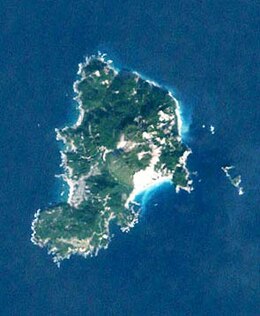Kōzushima
| Native name: 神津島 | |
|---|---|

Landsat image of Kōzu-shima
|
|
| Geography | |
| Location | Izu Islands |
| Coordinates | 34°12′58″N 139°09′23″E / 34.21611°N 139.15639°E |
| Archipelago | Izu Islands |
| Area | 18.48 km2 (7.14 sq mi) |
| Length | 6,000 m (20,000 ft) |
| Width | 400 m (1,300 ft) |
| Coastline | 22,000 m (72,000 ft) |
| Highest elevation | 571 m (1,873 ft) |
| Administration | |
|
Japan
|
|
| Demographics | |
| Population | 1914 (September 2009) |
Kōzu-shima (神津島?) is a volcanic Japanese island in the Philippine Sea. The island is administered by Tōkyō and located approximately 30 kilometres (19 mi) northwest of the Miyake-jima and 14 kilometres (8.7 mi) southwest of the Nii-jima. It is one of the Izu Seven Islands group of the seven northern islands of the Izu archipelago. Kōzushima is administratively part of Kōzushima Village under Ōshima Subprefecture of Tokyo Metropolis. As of 2009[update], the island's population was 8,363. Kōzushima is also within the boundaries of the Fuji-Hakone-Izu National Park.
Kōzu-shima is a compound volcanic island 6 km in length with a maximum width of 4 km. The island is formed from a cluster of eighteen lava domes, with rhyolite and pyroclastic ash deposits. The highest of these lava domes, Tenjō-san (天上山?), has a height of 571 metres (1,873 ft), and was last active in 838 AD per the ancient Japanese history Shoku Nihon Kōki. Compared with most of the other islands in the Izu archipelago, Kōzu-shima is relatively flat, with small eroded hills, and lacks the high coastal cliffs found on the other islands. Earthquake swarms have occurred at Kōzu-shima during the 20th century.
...
Wikipedia

